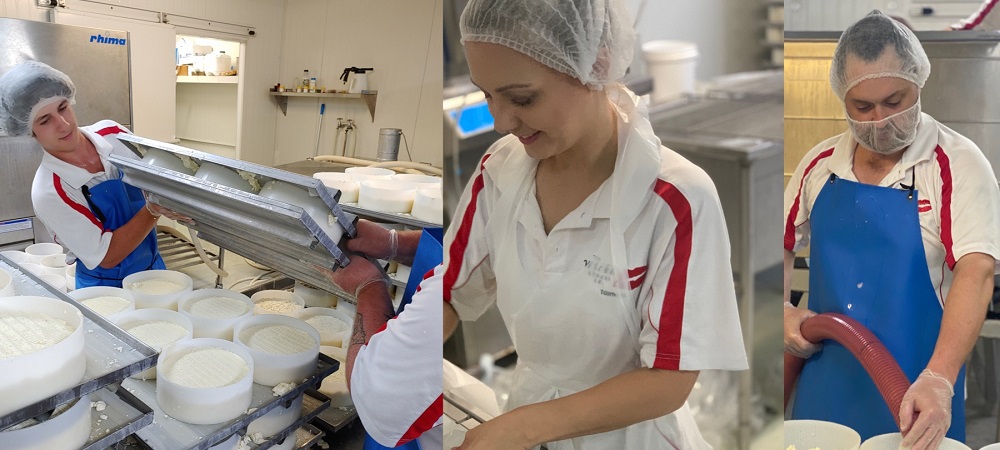Behind the Scenes with Cheese Makers Melbourne: Including Floridia Cheese
Behind the Scenes with Cheese Makers Melbourne: Including Floridia Cheese
Blog Article
Unlocking the Keys of Artisanal Cheese Making: A Step-by-Step Do It Yourself Guide
In the world of culinary craftsmanship, artisanal cheese making stands as a testament to the fragile balance in between custom and advancement. Each action in the process, from selecting the best milk to refining aging techniques, holds within it a riches of understanding gave with generations. As we start this journey to debunk the art of developing splendid cheeses, we are confronted with a tapestry of tricks and skills waiting to be untangled. Join us as we check out the intricacies of this old craft, where scientific research, persistence, and art converge to create flavors that tantalize the detects.
Choosing the Right Milk
When getting started on the trip of artisanal cheese making, the choice of milk plays a critical role in figuring out the quality and qualities of the final item. The kind of milk chosen influences the taste, appearance, and generally profile of celebrity. Raw milk, directly from the animal, is favored by many artisanal cheesemakers as a result of its unique mix of enzymes, germs, and taste compounds. However, using raw milk features risks and regulations, making pasteurized milk a more secure option for newbies.
Furthermore, the resource of the milk, whether from cows, goats, lamb, or buffalo, contributes distinct tastes and attributes to the cheese. Each kind of milk brings its own nuances, enabling for a broad range of cheese selections to be crafted based on the picked milk.
Culturing and Coagulating
To launch the cheese-making procedure, the crucial steps of culturing and coagulating need to be thoroughly performed to change milk into curds and whey. Culturing entails presenting valuable microorganisms to the milk, which after that starts the fermentation procedure. These germs transform lactose (milk sugar) into lactic acid, creating the acidic atmosphere needed for coagulation. The sort of society made use of can considerably impact the flavor, structure, and ripening of the final cheese item.

The timing and temperature control during culturing and coagulation are vital elements that influence the last end result of celebrity. Appropriate implementation of these actions is vital to ensure the preferred texture, flavor, and uniformity of the artisanal cheese being produced.
Draining and Pushing Curds
After the milk proteins have coagulated and the curds have been cut to launch whey, the following crucial action in artisanal cheese making involves draining and pressing the curds to accomplish the desired appearance and consistency of the last cheese product. Draining pipes is the process of separating the curds from the whey. This can be done by read this article transferring the curds right into a cheesecloth-lined bowl-shaped sieve or mold and mildew and allowing the whey to drain off naturally. The moment for draining pipes can differ depending on the kind of cheese being made and the preferred dampness web content.
As soon as the curds have actually sufficiently drained pipes, the next step is pushing. Pressing aids eliminate any staying whey and compacts the curds to develop a strong cheese wheel. Pushing can be done making use of specialized cheese presses that apply mild and consistent pressure over an amount of time. The period and stress applied throughout pushing will influence the final texture of the cheese, from soft and creamy to tough and company. Correct draining and pressing are critical steps that dramatically impact the top quality and attributes of the artisanal cheese being created.
Aging and Flavor Techniques
Executing precise aging and flavoring techniques is pivotal in enhancing the deepness and complexity of artisanal cheeses, elevating their preference profiles to charming levels of improvement and sophistication. Aging plays an essential duty in establishing the special tastes and structures that distinguish artisanal cheeses.
Flavoring strategies likewise contribute dramatically to the last preference of artisanal cheeses. Cheesemakers may choose to introduce additional flavors by including ingredients such as herbs, flavors, or also fruits into the cheese throughout the production procedure. Additionally, some cheeses are washed or rubbed with different liquids, such as salt water or alcohol, to boost their appearances and tastes.
Wrapping and Storing Cheeses

Conclusion
Finally, mastering the art of artisanal cheese making entails very carefully choosing the appropriate milk, adhering to precise culturing and coagulating processes, draining pipes and pressing curds properly, and utilizing various aging and flavor strategies. By following these actions diligently and with focus to information, you can develop your very own delicious and one-of-a-kind cheeses in the house. Remember to wrap and save your cheeses properly to make certain optimal flavor and structure development. Delighted cheese making!
Each kind of milk brings its own nuances, allowing for a wide variety of cheese Continued selections to be crafted based on the picked milk.After the milk proteins have coagulated and the curds have been reduced to launch whey, the following essential action in artisanal cheese making entails draining pipes and pressing the curds to accomplish the wanted appearance and consistency of the final cheese product. The majority of cheeses ought to be covered in wax paper or cheese paper to permit them to breathe while securing them from drying out. For cheeses that need to proceed aging, such as bloomy rinds or washed rinds, ensure they are kept in an amazing environment like a cheese cavern or a fridge established to the proper temperature. By paying attention to the wrapping and storage space of artisanal cheeses, cheese makers and fanatics can preserve the integrity of these specials and completely enjoy their complex flavors.
Report this page